How to clean the well: it all depends on what we will fight
Having realized the construction of a well, you will definitely have to constantly be engaged, not even in its maintenance, but in caring for this “your child”. Otherwise, if you let everything go on gravity, the price of carelessness will be very high - the water in the well will smell, stains and "flowers", you will not use it, you will not be able to "throw it away".
So he will stand a monument to your mismanagement.

Installation errors entail serious difficulties.
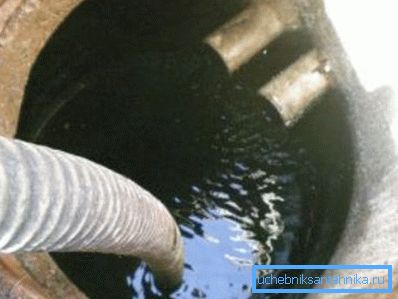
To avoid this, outline a plan for the arrangement of the well from the very beginning.
Construction features
Already in the design lay the following protective actions:
- choose the right construction site for the well, away from all kinds of warehouses and landfills; in this regard, it does not interfere with getting to know the neighbors and finding out the condition of the soils with them - you most likely will have exactly the same;
- most carefully equip the bottom of the well according to the scheme shown in Figure “A”, here:
- A - ideally rammed layer of sand;
Helpful advice! For the lower layer, we recommend the use of hardened sand, treated with high temperature.
- B - the so-called river bed - coarse sand; We pay attention, this structure does not contribute anything new to the “science” of protection - it is still the same multi-layer structure, it is only necessary to strictly follow the sequence of laying layers;
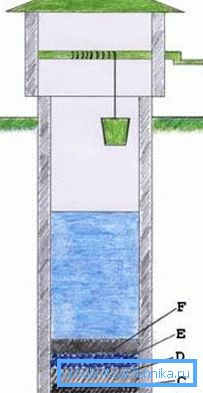
- C - schungite is a very ancient mineral, used from time immemorial in wells for water purification; the mineral has excellent absorbing properties, in addition, it is able to disinfect water;
- D is a layer of anthracite coal;
- E is quartz;
- F - silicon - the last two layers can be combined into one of quartz gravel.
- the rings forming the well should be precisely matched to each other, and the joints should be concreted;
- if it is intended to drain water from the well to the house, then this is done below the ground freezing level, and the drain hole itself must be completely sealed;
- very useful is the installation in the side walls of the well, the so-called side cement filters that do not allow the ingress of dirty water; These side filters can have three types of configuration:
- A - straight, the simplest;
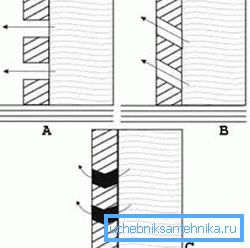
- B - at an angle, notice the rise inward to the side of the well, which further complicates the penetration of water;
- C - cone "down-up", again, the rise in the direction of the well.
- if a pump is to be used in the well, then place it not lower than 50 cm from the bottom so that it does not lift sediment during operation;
- be sure to equip a protective ridge with a lid above the well;
- and, it is very important to protect the entire area of the upper part of the soil at a distance of at least one and a half meters around the perimeter of the well with a clay castle, which will prevent melt and rainwater from entering the groundwater near the well.
If all these actions are taken, then you will have to fight for the purity of the water less.
And yet, for what and how we fight
However, the water in the well may over time and not suit you.
Water with silt and sand
There are several reasons:
- first, the pump is too low;
- secondly, you did not properly equip the bottom;
- thirdly, over time, too much sediment has accumulated, which cannot be eliminated - time does its job;
- Fourthly, the well filter does not cope with the work.
To solve the problem, in any case, you will need:
- complete removal of water from the well;
- its complete cleaning, including the side walls;
- putting in order, as stated in the instructions, the bottom;
- correct installation of the pump;
- cleaning the well filter and even replacing it with a more powerful one, if necessary.

In the water, oil stains
A terribly unpleasant situation, you may be familiar with it, if you ever tried to get rid of the remnants of sunflower oil in a bottle - it is almost hopeless, it is better to throw the bottle away.
Well you will not throw away the well and you need to do something and it does not matter how oil got inside.
For getting rid of oil we recommend:
- first of all, establish and eliminate the cause of ingress of oil inside; it may have just flowed out of the faulty pump;
- Do not remove water from the well, and gradually absorb the collected fraction to the absorbent added to the surface of the water - the main idea is to prevent the oil film from settling onto the surface of the well walls, then it will be more difficult to remove it many times;
- gradually reduce the water level and continue to add absorbent and collect plaque from the surface;
- perhaps, in this way, you will be able to achieve the goal without completely removing the water from the well, although the volume of this work depends on how much oil has "thrown" into the well.
Helpful advice! We advise you not to forget, if for some time, when the oil was already in the well, and the water intake system was working in the house water supply system, it is necessary to clean all the water supply lines to the house - from pipelines to an additional tank in the house. Already from this it can be understood that the contamination of the well with oil is a real disaster, which must be avoided in every way.
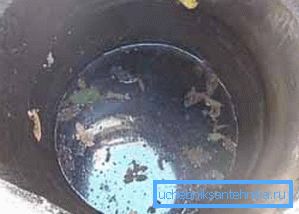
Iron taste
Very often, cleaning water is to protect against excess iron in the water, hence the unpleasant taste and unpleasant smell.
To clean iron, you can use:
- filtering using special filters; usually such filters are cascade in nature, are cleaned in stages and are fine filters;
- aeration, when water is highly saturated with a large amount of oxygen, which causes oxidation of iron and its precipitation; this will certainly be followed by regular steps to remove the sludge;
- coagulation, which consists in exposing water to special substances that neutralize iron molecules and also send all the impurities to the sediment; most often, aluminum sulfate is used as a coagulator, which is a white salt;
- by flotation, when water is also saturated with substance, but which causes the rise of “seized” iron to the top; This approach makes it easier to further clean the plaque from the surface of the water.
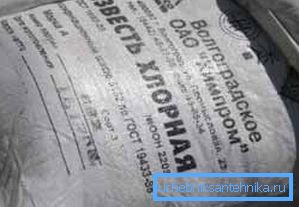
These ubiquitous bacteria
The presence of bacteria in the water is a direct result of our mismanagement.
Yes, you just have to:
- rule to organize the bottom of the well;
- regularly clean the well from the top of the flown leaves, and,
- Do not allow the construction of a well literally two meters from the sump.
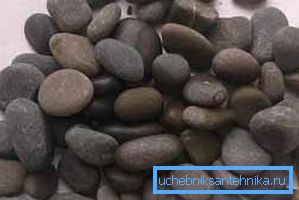
If the bacteria are bred, you will have to:
- drain the whole well;
- adjust the bottom
- carefully remove all visible flora and fauna inside the well, and then,
- process the entire surface always saving bleach in these cases;
Helpful advice! Instead of bleaching powder, you can use bleach and lime, but first you need to brew it in a separate container, and before applying it also remove a rather abundant sediment.
- you can use any other available biologically active agent, the main thing
- do not forget the entire inner surface of the well then more than once and not rinse two.
findings
Cleaning the well is a very time consuming and to some extent a thankless task, there is no absolute guarantee that the result will suit you completely. Nevertheless, we are not allowed to do what electronic engineers do when repairing the same computer: they simply throw out the hard drive, simply delete the system and install a new or new one.
It will be necessary to work with the well, but pay attention to the ways of designing this structure given at the beginning of the article. The more accurately everything will be done from the very beginning, the less it will have to suffer then. Perhaps, to some extent, your torment will be able to soften our additional video in this article, be sure to pay attention to it.